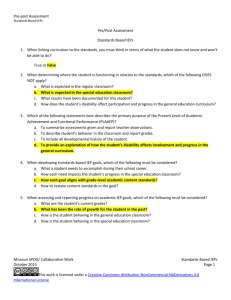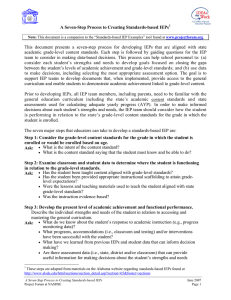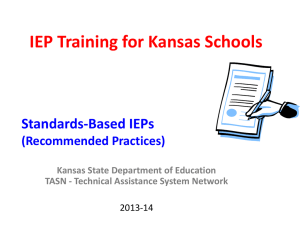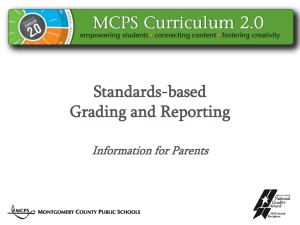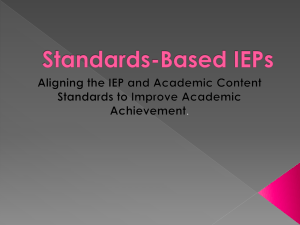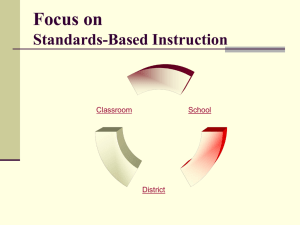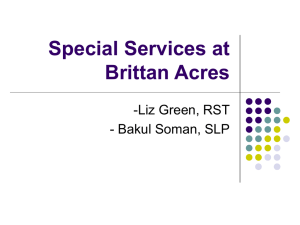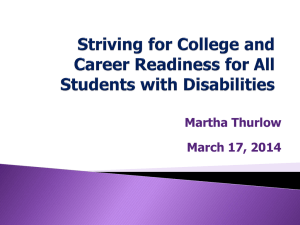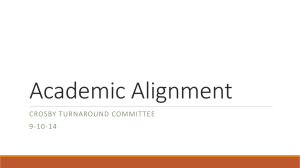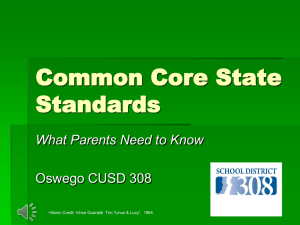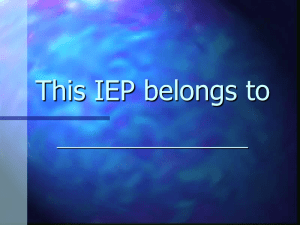Rigorous Curriculum Defined
advertisement
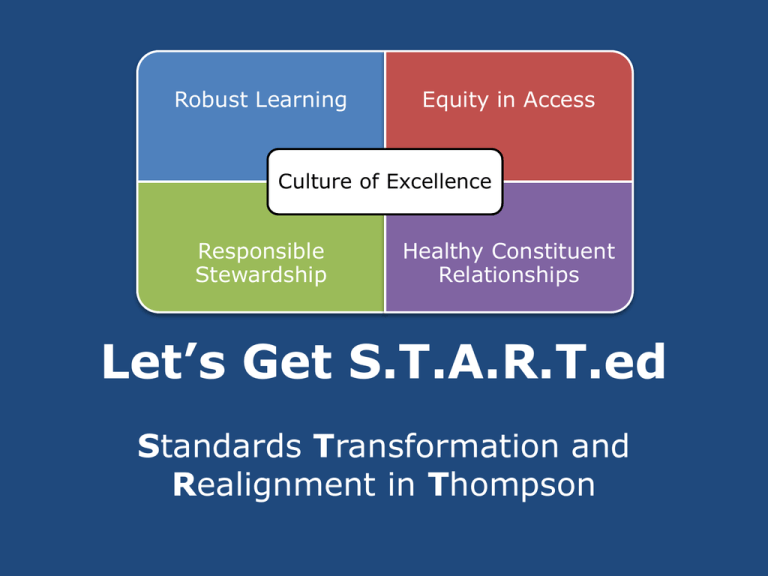
Robust Learning Equity in Access Culture of Excellence Responsible Stewardship Healthy Constituent Relationships Let’s Get S.T.A.R.T.ed Standards Transformation and Realignment in Thompson • The Context for Change Vision 2020 – Thompson MVV + SP (Mission, Vision, Values & Strategic Plan) We are living in an era of • • • • Global Interconnectivity Cultural Diversity Knowledge/Information Economy Rapid, Exponential Change • The Context for Change Vision 2020 – Thompson MVV + SP (Mission, Vision, Values & Strategic Plan) We are realigning our system so every child • has access to robust teaching, learning, and high expectations • graduates from high school career and college path ready with the knowledge and skills to be a lifelong learner and successful citizen • The Content of the Change Systemic & Continuous Improvement • Robust Learning Cycle – Curriculum – What should students learn and why? – Assessment – How will we know they know/can do? – Instruction – How will we teach to ensure they learn? What will we do when they don’t learn or learn prior to expectation? – Communication – How will we communicate what they have learned/still need to learn? • The Content of the Change • The Implementation of Change Standards Transformation Logic Model 2010 - 2014+ Identifying the Key Responsibilities within each Component • • • • Standards Awareness & Alignment Robust Learning Cycle Content Standards-Based Grading/Reporting/IEPs Family & Community Engagement • The Process of Change Backwards Design Process “Beginning with the End in Mind” The Literature • Rigorous Curriculum Design - Ainsworth • Understanding by Design - Wiggins/McTighe • Assessment for Learning - Stiggins Thompson School District Rigorous Curriculum Design Rigorous Curriculum Defined A rigorous curriculum is an inclusive set of the following intentionally aligned components organized into sequenced units of study: Clear learning outcomes Matching assessments Engaging learning experiences Instructional strategies Rigorous Curriculum Defined A rigorous curriculum serves as both the detailed road map and the high quality delivery system for ensuring that all students achieve the desired end: the attainment of their designated grade or course specific standards within a particular content area. A Rigorous Curriculum Design Supports the Robust Learning Cycle 1. What do all students need to know and be able to do? (Standards) 2. How do we teach so that all students learn? (Instruction) 3. How will we know if they have learned it? (Assessment) 4. What will we do if they don’t know or come to us already knowing? (Differentiation and Enrichment) 7 Steps to Standards-based IEPs This 7 step process can help school personnel to: a.) consider each student’s strengths and needs to develop goals focused on closing the gap between the student’s levels of academic achievement and grade level standards; and b.) use data to make decisions. Goals To support IEP teams to develop documents that, when implemented, provide access to the general curriculum and enable students to demonstrate academic achievement linked to grade-level content. To guide IEP teams to make informed decisions about each student’s strengths and needs and how the student is performing in relation to the state’s gradelevel content standards for the grade in which the student is enrolled. Creating Standards-based IEPs Creating Standards-based IEPs 1. Consider the grade-level content standards for the grade the student is currently enrolled. •What is the intent of the content standard? •What is the content standard saying that the student must know and be able to do? Creating Standards-based IEPs 2. Examine student data to determine where the student is functioning in relation to the grade-level standards. • • • • Has the student been taught content aligned with grade-level standards? Has the student been provided appropriate instructional scaffolding to attain grade-level expectations? Were the lessons and materials used to teach the student aligned with state grade-level standards? Was the instruction evidence-based? Creating Standards-based IEPs 3. Develop the present level of academic achievement and functional performance. • • • • • • What does the progress monitoring data tells us? What programs, accommodations, and/or interventions have been successful? What does the previous IEP tell us? How does the student's disability affect participation and progress in the general curriculum? What supports does the student need to learn the knowledge and attain the skills to progress in the general curriculum? What does the gap analysis tell us? Creating Standards-based IEPs 4. Develop measurable goals aligned with grade-level academic content standards. • • • • • What are the student’s needs as identified in the present level of performance? Does the goal have a specific timeframe? What can the student reasonably be expected to accomplish in one school year? Are the conditions for meeting the goal addressed? How will the outcome of the goal be measured? Creating Standards-based IEPs 5. Assess and report the student’s progress throughout the year. • • • How does the student demonstrate what he/she knows on classroom, district and state assessments? Are a variety of assessments used to measure progress? How will progress be reported to parents? Creating Standards-based IEPs 6. Identify specially designed instruction including accommodations and/or modifications needed to access and progress in the general education curriculum. • • • What accommodations are needed to enable the student to access the knowledge in the general education curriculum? What accommodations have been used with the student and were they effective? Has the complexity of the material been changed in such a way that the content has been modified? Creating Standards-based IEPs 7. Determine the most appropriate assessment option. • • • What accommodations are allowed on district and state assessments? Are those accommodations currently being used in the classroom? What can be learned from the student’s previous state and district assessment results? Expectations 1. All staff must be actively involved in the standards transformation. 2. This process will require reflection and adjustment to current practices. 3. Exemplar standards-based IEPs by 2014. Questions?
